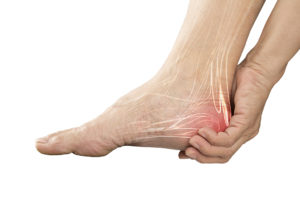
If you feel persistent pain in your heel, it may mean more than a bad shoe day or too much time on your feet.
You could be suffering from an increasingly common condition known as plantar fasciitis.
With home fashion trends moving from carpeting to hardwood and tile floors, more Americans suffer from this aggravating, seemingly ever-present plantar pain.
Marisha Stawiski, DPM, a Spectrum Health Medical Group podiatrist and foot and ankle surgeon, identified some steps you can take to heal your heel.
1. What is plantar fasciitis?
Plantar fasciitis is the most common cause of heel pain. It is an inflammation of a thick band of tissue that runs across the bottom of your foot and connects your heel bone to your toes. This tissue is called your plantar fascia. It generally isn’t caused by one specific injury, but rather by a long-term strain and irritation to the plantar fascia.
2. How do I know if I have plantar fasciitis?
The only way you can know for sure if your pain is coming from the plantar fascia is if you visit your foot and ankle specialist or your primary care doctor. The majority of heel pain does stem from plantar fasciitis, though. So if you are suffering from pain in your heel or arch, there is a high likelihood it is coming from plantar fasciitis.
3. Is it hereditary?
Plantar fasciitis is not hereditary, but it is more common with certain foot types—and the type of foot or arch that we have is genetic. But it is important to understand that the actual diagnosis of plantar fasciitis is not hereditary.
4. What makes a person more prone to developing plantar fasciitis?
Individuals with plantar fasciitis often exhibit very tight structures in their lower extremities. They often have tight calf muscles and their plantar fascia is generally tight as well. Plantar fasciitis is seen more frequently in patients who spend a lot of time on their feet standing, but also walking. This is the case especially in individuals who are spending their time on hard surfaces all day (concrete, tile, hardwood floors). Higher rates of plantar fasciitis occur in people who have arches that are lower or higher than normal. That being said, anyone can get plantar fasciitis.
5. Does it get worse with age?
Age is not a big factor in developing plantar fasciitis.
6. Can losing weight help the symptoms?
Many individuals with plantar fasciitis are not overweight. Those who are overweight, though, can certainly benefit from weight loss. Excessive weight is one factor in the development of plantar fasciitis, but it is definitely not the only factor. Dr. Stawiski encourages patients who are significantly overweight to address this issue as excessive weight puts a tremendous amount of strain on the plantar fascia.
7. Why does it sometimes affect only one foot?
This is a question Dr. Stawiski gets all of the time. No one knows exactly why we often see plantar fasciitis on one extremity and not the other. Our extremities are generally very similar in architecture and biomechanical function, and therefore it would make sense that if one side develops the problem both should. This is often not the case though and it likely has something to do with subtle biomechanical or structural differences from one side to the other. For example, if an individual has a tighter calf muscle on one side than the other, the tight side is much more prone to developing plantar fasciitis. Also, our dominant side, be it left or right, could also factor in at times.
8. Does walking increase the pain?
For most patients, walking is a trigger for increasing pain associated with plantar fasciitis. Standing in one place for long periods is an even bigger trigger. Standing and walking on hard surfaces without good support also increases the pain.
9. What type of footwear is recommended?
In general, it is important to wear supportive shoes with a more rigid construct and a stiff sole. A high-quality running shoe is often what patients do the best in. Dr. Stawiski generally recommends some form of orthotic to put inside the shoe as well. This is something a specialist could elaborate on further if you were to be seen for plantar fasciitis.
10. What can I do to relieve the pain?
There are some easy things that can be attempted on your own without the assistance of a specialist if you are experiencing symptoms secondary to plantar fasciitis:
- Stretch your calf muscles (e.g., runner’s wall stretch).
- Wear supportive, high-quality shoes with good arch support and a rigid sole
- Ice the heel and arch with a frozen water bottle.
- Avoid walking or standing barefoot. Even in the house, wear support.
- Try an over-the-counter orthotic insert.
- Roll the arch with a tennis ball.
11. When should I see a doctor?
It is never too soon to see someone if you suffer from heel or arch pain. But if you attempt the above at-home therapies and the heel pain is still not improving, you should definitely see a doctor. Also, if your heel pain is sudden in onset, intense, or secondary to an injury, you should see a doctor and you should not try to treat this yourself.
12. What treatments are available?
We generally start off by confirming this diagnosis with a thorough physical examination and possibly radiographs. Once we have confirmed the diagnosis, there is a big emphasis on the following:
- Orthotic discussion
- Shoe gear discussion
- Stretching and rolling modalities
- Anti-inflammatory modalities (such as oral anti-inflammatories, icing) or injectable anti-inflammatories
- Sometimes physical therapy is necessary
- Sometimes night splinting is attempted
13. Does it ever go away on its own?
Plantar fasciitis often does go away, but it usually takes some effort on your own or with the help of a specialist.
14. Is surgery an option?
In some instances, after many months of attempted non-operative care, there is a small segment of patients who opt for surgery. This is definitely not a first-line form of treatment, though, and the majority of people with plantar fasciitis get better without the need for surgery. The procedure that is generally necessary involves releasing the tight structures that contribute to the development of plantar fasciitis.
15. Is plantar fasciitis more prevalent than it once was? If so, why?
Human beings really aren’t meant to stand on hard cement, tile or hardwood floors. These man-made floor constructs are likely a contributor to the high rate of people developing this condition. The best way to combat this is by wearing shoes and arch supports when standing and walking on hard surfaces.
16. Should I wear shoes at all times?
Most individuals with plantar fasciitis do much better if they wear at least some support in their home. Going barefoot on hard surfaces is very bad for calming down an actively inflamed plantar fascia.
 /a>
/a>
 /a>
/a>
 /a>
/a>
Is tight calf muscles in the absence of pain under the foot an indicator that you should be seen? I’m wondering if I’m trending toward getting plantar fasciitis. Thanks.
Hi Tom, Thank you for being a Health Beat reader and for being proactive about your health! Super tight calf muscles should be mentioned to your primary care provider during your next physical or visit. He or she will be able to best determine if this is something that should be investigated further. Best wishes to you!
I have problems with the tendons of calf tighting up when walking and more heel pain now at nite and in morning. I have lost weight and the calf problem has gotten better but the heel problem persist. i was wearing sandals as it was the only thing that i could wear but think this may have aggrivated it more after reading your info. i have new sketchers shoes and they are working better. may need a arch support as my arches are low.
thanks.
Good evening! I have had some pain now for about a week where it is painful to walk. It started with just one heel, but because I was favoring the heel it started in, now both are very sensitive to touch. It’s not under the heel of ny foot, but behind them, on the heel. I’ve been taking ibuprofen for pain. How long does this last?